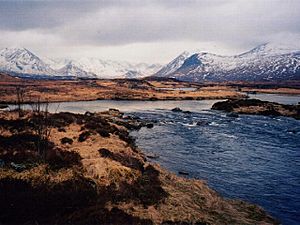Rannoch Moor facts for kids
Quick facts for kids Rannoch Moor |
|
|---|---|
| Mòinteach Raineach/Raithneach | |

The Black Mount, seen over the wild landscape
|
|
| Lua error in Module:Location_map at line 420: attempt to index field 'wikibase' (a nil value). | |
| Location | West of Loch Rannoch, Scotland, UK |
|
Designations
|
|
| Official name: Rannoch Moor | |
| Designated: | 5 January 1976 |
|---|---|
| Reference #: | 78 |
Rannoch Moor ( Scottish Gaelic: Mòinteach Raineach/Raithneach) is a very large area of wild, boggy land in Scotland. It covers about 130 square kilometers (50 square miles). You can find it west of Loch Rannoch. The moor stretches across parts of Perth and Kinross, Highland (Lochaber), and northern Argyll and Bute.
Rannoch Moor is a special place for nature. It is protected as a Site of Special Scientific Interest (SSSI). It is also a Special Area of Conservation. A large part of the moor is inside the Ben Nevis and Glen Coe National Scenic Area. This is one of 40 such beautiful areas in Scotland.
Contents
Amazing Wildlife
Rannoch Moor is famous for its unique plants and animals. One special plant is the Rannoch-rush. It is named after the moor because this is the only place in Britain where it grows!
The moor is also home to interesting ants. A scientist named Horace Donisthorpe visited often. He found many unusual ant types here. Today, it is still one of the few places where the "narrow-headed ant" (Formica exsecta) lives.
Building Roads and Railways
Building things on Rannoch Moor is very hard. This is because the ground is made of deep peat. Peat is like very soft, wet soil.
When the West Highland Line railway was built, engineers had a big challenge. They had to make the tracks float! They used a thick layer of tree roots, branches, and tons of earth and ash. This created a strong base for the railway.
Corrour railway station is on this line. It is the highest railway station in the UK. It is also one of the most remote, meaning it's far from any towns. The nearest public road is about 16 kilometers (10 miles) away! The railway line curves gently for about 37 kilometers (23 miles) across the moor.
The A82 road also crosses the western part of Rannoch Moor. It leads to places like Glen Coe and Fort William.
There was once a private railway station called Gorton. It was very isolated. It even had a school for the children of the railway workers who lived there.
How the Land Was Formed
Rannoch Moor was once covered by a huge sheet of ice. This happened at the end of the last ice age. It was the biggest ice field in the UK at that time.
When the ice melted, the heavy weight was lifted from the land. Because of this, the land is still slowly rising today. It moves up about 2 to 3 millimeters each year.
Rannoch Moor in Stories
Rannoch Moor has appeared in many books and TV shows.
- In the book Kidnapped by Robert Louis Stevenson, part of the story takes place here.
- The cartoon artist Don Rosa said that Castle McDuck is on Rannoch Moor. This is the old home of Scrooge McDuck's family.
- In the Highlander novel The Element of Fire, characters track a villain to Rannoch Moor.
Filming Location
The moor's wild landscape makes it a popular place for filming.
- It was used as a filming location for the TV series Outlander.
- A short scene in the movie Harry Potter and the Deathly Hallows - Part 1 was also filmed here.
See also
 In Spanish: Rannoch Moor para niños
In Spanish: Rannoch Moor para niños

